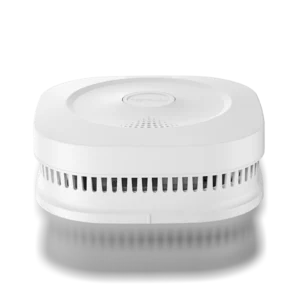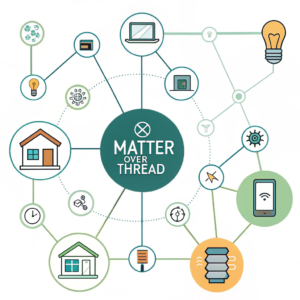Brief Summary:
To choose the right Matter devices for your smart home, you first need to understand that Matter is the “universal language” for devices, while Thread, Wi-Fi, or Ethernet are the “transportation” methods. A future-proof smart home should prioritize Matter over Thread devices for their superior energy efficiency and reliability. When shopping, always look for the official Matter certification logo and select a Matter compatible smart home hub that also supports Thread. For critical safety equipment, such as a Matter smoke detector, choose reputable brands.
Matter Smart Home Guide
Building a truly “future-proof” smart home begins with choosing the right Matter certified products. In the past, the smart home ecosystem was a mess of competing standards, with Apple, Google, and Amazon each in their own walled garden. Devices couldn’t communicate, trapping users within a single brand. Matter’s arrival has changed all of that.
Whether you’re a first-time buyer or upgrading your setup, understanding the benefits of Matter over Thread devices, choosing essential safety gear like a Matter smoke detector, and selecting a Matter compatible smart home hub can transform your living space. This comprehensive guide will provide you with everything from basic interoperability to advanced setup tips, helping you build a seamless, secure, and scalable smart home ecosystem with Matter compatible devices.
Matter: Universal Smart Home Language
Matter was created to solve the biggest headache in home automation: compatibility. As a cross-platform standard, it allows Matter compatible devices from different brands to communicate effortlessly. This is a revolutionary step, led by the Connectivity Standards Alliance (CSA), a consortium of major tech companies including Apple, Google, and Amazon. Here’s why it’s a game-changer:
- No Vendor Lock-In:You can freely mix and match brands without compatibility worries. A smart plug from TP-Link can be controlled by Google Home, and an Eve sensor can trigger an Amazon Alexa routine.
- One App to Rule Them All:You can manage all your Matter devices through your preferred smart home platform, eliminating the need for a separate app for every gadget.
- Local Control, Faster Response:Matter allows devices to communicate directly over your local network. This means your devices will work even if your internet is down, and their response time is significantly faster.
- Top-Tier Security:The Matter protocol includes mandatory, end-to-end encryption to ensure your smart home data remains secure.
Pro Tip: Look for the official Matter certification logo when shopping. This logo guarantees the device meets strict interoperability standards for both Matter over Thread devices and other connected products.

Matter vs. Thread: How They Work Together
Before you can choose the right devices, you need to understand a key distinction: Matter vs. Thread. They play very different but complementary roles. Think of it with a simple analogy:
- Matter is the “language”:It defines how devices talk to each other, for instance, “Light bulb, turn on” or “Sensor, what’s the temperature?”
- Thread is the “transportation”:It is the low-power wireless network that carries those instructions.
| Feature | Matter Protocol | Thread Network |
| Role | Standardized communication | Low-power wireless connectivity |
| Best For | Interoperability | Extending range via mesh networking |
| Key Insight | Allows different brands to work together | Delivers longer battery life and network reliability |
Core Insight: The best smart home experience comes from Matter over Thread devices. These devices (like smart sensors, lights, and plugs) leverage Thread’s low-power mesh network while using the Matter language to communicate. This makes them more energy-efficient and stable than Wi-Fi-only options, ideal for building a reliable ecosystem.
Essential Matter Devices for Your Smart Home
In your smart home journey, not all devices need Matter. High-bandwidth devices (like smart cameras or speakers) will still rely on Wi-Fi. However, for low-power, everyday automation, Matter over Thread is the superior choice. Here are the devices you should prioritize:
1. Smart Plugs
Smart plugs are the easiest way to start your smart home. By plugging any basic appliance (like a lamp or coffee maker) into a smart plug, you can control it with your phone or voice. Opting for a Matter over Thread smart plug, like those from TP-Link or Eve, significantly reduces power consumption and ensures a stable connection even far from your hub.
2. Smart Lighting
Smart lighting is great for setting the mood and saving energy. Matter compatible devices, such as Nanoleaf Essentials or Philips Hue bulbs, can be controlled seamlessly across platforms and can work with your other devices—for example, having the lights automatically turn on when your smart lock is opened.
3. Safety & Security
Safety devices are the most critical part of any smart home. Choosing Matter compatible devices means you can integrate different brands of locks, sensors, and alarms into a single system.
Matter Smoke Detector: This is a must-have for every home. When a smoke detector is triggered, it will not only sound an alarm but also use the Matter protocol to send an instant notification to your smartphone and trigger other actions (e.g., turning on all the lights or unlocking doors). Always choose a Matter smoke detector with battery backup to ensure it works during power outages.

4. Thermostats & Climate Control
A Matter-compatible smart thermostat lets you control your home’s temperature remotely and automate adjustments based on your routines. Since these devices require a stable connection, Matter over Thread provides a more robust mesh network than Wi-Fi, ensuring your thermostat is always online and responsive.
How to Choose a Matter Compatible Smart Home Hub
A Matter compatible smart home hub is the “brain” of your Matter network. It’s the device that coordinates everything, runs automations, and acts as a controller. If your devices are Matter over Thread devices, your hub must also function as a Thread Border Router to connect them to your home network and the internet.
Click here for more information: https://sensereo.com/community/the-ultimate-guide-to-choosing-a-matter-compatible-smart-home-hub/
Buying Matter Devices: Pitfalls to Avoid
To make sure you’re making a smart investment, be aware of these common pitfalls:
- “Works with Matter” vs. “Matter Certified”:Some products might claim to “work with Matter” but lack official certification. Only devices with the official Matter certification logo guarantee true interoperability and security. Always look for the official logo from the Connectivity Standards Alliance (CSA).
- Upgrading Older Devices:Not all older devices can be updated to support Matter via a firmware update. Many require specific hardware to function. Before you buy, check the manufacturer’s website for their Matter upgrade timelines.
- Network Configuration:While a Matter over Thread network is self-healing, you may still need to strategically place your hubs and devices in a large home to ensure solid network coverage.
Future-Proofing Your Smart Home
By choosing Matter compatible devices, you’re investing in a system that can grow and evolve with technology. Here are a few tips for building a reliable, long-term smart home:
- Prioritize Matter over Thread Devices:They are not only energy-efficient, but your network also becomes more robust with every device you add.
- Enable Auto-Updates:Make sure all of your Matter compatible devices have auto-updates enabled. As the Matter standard evolves, your devices will get the latest features and security improvements.
- Start Small, Expand Slowly:Begin with a couple of Matter over Thread devices and a Thread-enabled hub, then expand gradually as your needs grow.

Final Thoughts: Your Smarter Home Starts Here
With Matter, the smart home is no longer a complex world for tech enthusiasts alone. It’s becoming simpler, more reliable, and more secure for everyone. Whether it’s a Matter smoke detector that alerts your phone in an emergency or a Matter compatible smart home hub that unifies all your gadgets, the future of home automation is seamless. The debate of Matter vs. Thread becomes irrelevant when you have devices that leverage both protocols effectively.
Explore More of Sensereo’s Smart Home Products
FAQ
Q: What are Matter devices?
A: Matter devices are smart home products that use the Matter standard to communicate across different platforms like Apple Home, Google Home, and Amazon Alexa, ensuring they all work together.
Q: What do I need for Matter devices?
A: To use Matter devices, you need a Matter controller, which is often a smart hub like the Apple HomePod Mini or Google Nest Hub. If you are using Matter over Thread devices, your controller must also have a Thread Border Router built-in to connect them to your home network.
Q: What smart devices are compatible with Matter?
A: Matter is compatible with many types of smart devices, including smart smoke detector (like the Sensereo MS-1), lighting, locks, sensors, thermostats, and blinds.
Q: Is Matter Bluetooth or Wi-Fi?
A: Matter is a software protocol, not a type of connection. It uses existing wireless technologies like Wi-Fi and Thread to send its commands. Bluetooth is specifically used for the initial setup process.
Q: How do I set up a Matter device?
A: Setting up a Matter device is simple: you just scan a QR code or enter a numerical code provided with the product, and your controller handles the rest.
Q: What are the 4 types of matter?
A: In the context of smart homes, this question is not relevant. The four types of matter refer to the states of matter in science (solid, liquid, gas, and plasma), which is unrelated to the Matter smart home standard.
Q: What are the benefits of Matter devices?
A: Matter devices offer several benefits, including true interoperability across brands, simplified setup, enhanced security, and the ability to work locally without an internet connection. Products that use Matter over Thread, like the Sensereo MS-1, also offer superior energy efficiency.



